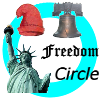Measures of Freedom
Human Freedom Index [PDF],
The Human Freedom Index 2021
2019: 6.83, Rank: 101, Personal Freedom: 6.42, Economic Freedom: 7.42
Level of Economic Freedom,
Economic Freedom of the World
2014: 7.01, Rank: 80
Philippines | Freedom House,
Freedom in the World 2022
2016: Status: Partly Free, Aggregate Score: 65, Political Rights: 3, Civil Liberties: 3
A deadly gun battle in January, combined with technical legal challenges, derailed progress in 2015 on congressional ratification of the Bangsamoro Basic Law (BLL), under which a new self-governing region, Bangsamoro, would replace and add territory to the current Autonomous Region in Muslim Mindanao (ARMM). The BLL was the next step outlined in a landmark 2014 peace treaty between the government and the Moro Islamic Liberation Front (MILF), the country's largest rebel group.
Articles
Killing in the Name of Democracy, by
James Bovard,
Attention Deficit Democracy, 27 Jan 2006
Excerpt from the chapter 4 "Messianic Democracy" of Bovard's
Attention Deficit Democracy (2006), details various U.S. presidents' policies and actions from McKinley to Eisenhower
[After] a swift victory, the United States annexed all of the Philippines. As Tony Smith, author of America's Mission, noted, "Ultimately, the democratization of the Philippines came to be the principal reason the Americans were there; now the United States had a moral purpose to its imperialism and could rest more easily." ... The United States Christianized and civilized the Filipinos by authorizing American troops to kill any Filipino male 10 years old and older and by burning down and massacring entire villages. (Filipino resistance fighters also committed atrocities against American soldiers.)
A Libertarian Visits Cuba, Part 1, by
Jacob G. Hornberger,
Freedom Daily, May 1999
Reviews Cuban history from their independence war, through the Batista regime, the Castro revolution, the Bay of Pigs invasion and more current events, leading up to a week's visit to Cuba to study their socialist system
The Cubans were perhaps fortunate not to have resisted the new American imperialism more forcefully. The Philippine Islands had also rebelled against Spain, and after Spain's surrender, Filipinos had to fight a new, brutal war for independence against their U.S. government "saviors"—a war that resulted in tens of thousands of Filipino deaths and more American casualties than the original war against Spain. (See "American Foreign Policy—The Turning Point" by Ralph Raico in Ebeling and Hornberger, eds., The Failure of America's Foreign Wars.)
The Spanish-American War: The Leap into Overseas Empire, Part 2, by
Joseph R. Stromberg,
Freedom Daily, Jan 1999
Discusses the Philippine-American War, that followed the Spanish-American War, and the actions and writings of the Anti-Imperialist League, William Graham Sumner and other opposed to the war and colonialism
In February 1899, uneasy relations between U.S. forces and the Filipino insurgents turned into actual fighting. America was now to learn the sorrows of empire along with its joys. Rallying under the slogan ... 'There is no right to sell a nation like a sack of potatoes', Filipinos flocked to the forces of Aguinaldo and Mabini to oppose the new colonial masters. ... As of July 1902, when the United States declared the Philippine Insurrection over, 200,000 to 220,000 Filipinos had died, of whom only 15,000 were actual combatants, which suggests that U.S. forces consciously made war on the enemy's entire society ...
The Spanish-American War: The Leap into Overseas Empire, Part 1, by
Joseph R. Stromberg,
Freedom Daily, Dec 1998
Describes the political and other forces that led to the Spanish-American War, the military actions in Cuba and the Philippines and the immediate aftermath
One immediate result of the war was the American-Philippine War (or as the United States called it, the Philippine 'Insurrection'), which was much less happy and which disappeared from national memory ... a successful war with Spain could lead to cession ... of key properties in the Pacific Ocean, especially the Philippine Islands, which would make ideal jumping-off points – coaling stations and military outposts – to the markets of East Asia. ... McKinley told his peace commissioners that the United States must have Manila and its harbor, but by mid November he was insisting on all the Philippine Islands.
